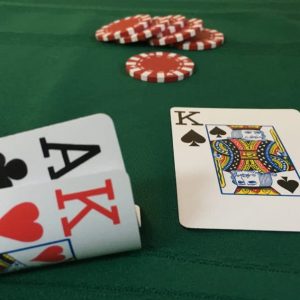Stud Strategy – Playing Pairs on Third Street

The majority of strategy you see around the internet focuses primarily on Texas Hold’em and specifically NL Hold’em. Starting today, we will present a series of articles that focus primarily on mixed game strategy.
We will start with Seven Card Stud. Stud is one of the oldest forms of poker that’s still regularly offering in live casinos. While you may seldom see it in cash game format, you will see it a lot in mixed game tournaments such as 8-Game and Dealer’s Choice.
In today’s article, we will begin a multi-article look at starting hands. We will start by looking at playing pairs in Stud Hi.
Split Pairs
The most common form of pair you will see in Stud is a split pair. This is when your door card (the first card dealt face up) creates a pair with one of your hole cards. Playing split pairs depends a lot on your position and the cards that are ahead of you in the hand.
For example, if you start with a split pair of eights through tens, you’re looking primarily to either call the bring-in or play it heads-up against a single completion. If you’re in late position and are the high card on board, you can complete the bet. However, doing so commonly telegraphs that you have a split pair or a big pair underneath.
You will largely want to stay away from playing split pairs under eights unless you either have a big kicker or can come in for just the bring-in. Also, when playing eights through tens, you want to stay away from calling two bets with these hands.
You big split pairs are good hands to complete with, especially if you have the high door card or in late position. Raising or three-betting should largely be reserved for queens and up. Also, if you complete or raise with a split pair and an undercard decides to raise it up, then they might be playing with a bigger buried pair than you.
Buried Pairs
Buried pairs are when your two down cards make a pair. These are great hands to speculate with because the strength of your hand is hidden. In many cases, you are going to be calling a bring in or completion with these hands and hoping to improve your hand by Fifth Street.
Note that completing or raising with a buried pair tends to make other player suspicious, especially if you are raising with a card under 10 or if a bigger card has already entered the hand. This is practically telegraphing that you have a big buried pair underneath.
Buried pairs are great hands to try and trip mine. If you hit trips with a buried pair, your hand will be well hidden. If it improves further, you may get paid off handsomely.
Don’t go overboard playing big pairs on Third Street against multiple bets. Small buried pairs should be folded to multiple bets. If you call with a big buried pair and improved, don’t be surprised if the initial raiser slows down.
How Strong is Your Kicker
Something mentioned earlier with split pairs is the strength of your kicker. When playing a pair, take your kicker into consideration, especially when making a borderline decision regarding middle or low buried pairs.
A pair with a weak kicker, such as sixes with a 7 kicker, isn’t going to make a very strong pair if you happen to pair that kicker. However, if you have sevens with an ace, then you can potentially improve to aces up and you may want to consider taking another card.
In borderline decision with your pair on Third Street, lean towards calling with big kickers and folding with weaker ones. If you have a bigger pair (such as tens, jack, or even queens) with a weak kicker, consider folding it to considerable strength, such as when there’s a completion and a raise ahead of you.
Pay Attention to Door Cards
Stud allows you to pick up a lot of information about the potential strength of your hand thanks to door cards. If you have a split pair of queens with a king and there’s a king and queen already showing, you know your hand is in much worse shape than if you had split jacks with a ten and none of your cards showing.
If cards for both your pair and your kicker are showing, that’s ample reason to fold to anything more than a bring-in. If more than two of your kicker is showing, you can make the same consideration unless your pair is jacks or better.
When all of your outs for your pair are showing, abandon the hand. The only exception may be aces. However, realize that smart players that see three of the same card on board will know that the card that plays probably has a pair that can’t improve to trips.
In our next Stud strategy piece, we will discuss playing three-card straight starting hands.
